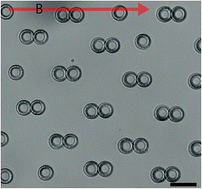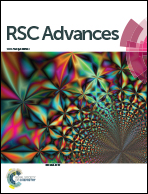Solid microscopic rings formed via wetting and subsequent dewetting†
Abstract
We report the spontaneous formation of rings when a colloidal dispersion, containing silica-coated iron-oxide particles and the liquids ethanol and ethoxylated trimethylolpropane triacrylate, is deposited within micron-sized PDMS wells. Just after filling, the interface between air and the dispersion is a meniscus dictated by the dispersion's contact angle on PDMS. Upon evaporation of ethanol the meniscus lowers and, if a critical volume is reached, a rupture process is initiated and the dispersion adopts a ring morphology. The final dispersion consists only of particles and ethoxylated trimethylolpropane triacrylate that can be reticulated to solidify the ring geometry. The colloidal particles within the dispersion are essential for the stability of the rings prior to the reticulation. Here, by using iron-oxide based colloidal particles we fabricated superparamagnetic rings, opening up new avenues for applications. The dimensions of the rings can be tuned by adjusting both the size of the PDMS wells and the amount of ethanol in the dispersion. In this manner it is possible to fabricate rings with annuli smaller than a micron – a scale below the lower limit of standard lithography. Calculations assuming an equilibrium contact angle of ethoxylated trimethylolpropane triacrylate on PDMS reproduce the experimental results strikingly well.


 Please wait while we load your content...
Please wait while we load your content...